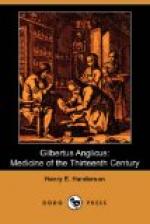Dislocation of the elbow is reduced by passing a bandage around the bend of the arm, forming in this a loop (scapham) into which the foot of the surgeon is to be placed for counter-extension, while with the hands extension is to be made upon the forearm until the bones are drawn into their normal position. Flexion and extension of the joint are then to be practised three or four times (to assure complete reduction?), and the forearm flexed and supported by a bandage from the neck. After a few days, Gilbert tells us, the patient will himself often try to flex and extend the arm, and the bandage should be so applied as not to interfere with these movements.
Dislocation of the wrist is reduced by gentle extension from the hand and counter-extension from the forearm, and dislocation of the fingers by a similar manipulation.
After so full a consideration of the surgical injuries of the head, trunk and upper extremities, we are somewhat surprised to find Gilbert’s discussion of the similar injuries of the lower extremities condensed into a single very moderate chapter entitled “De vulneribus cruris et tybie” (f. 358a b).
In this, Gilbert, emphasizing the importance of wounds of the patella and knee-joint and the necessity for their careful treatment, also declares that wounds of both the leg and thigh within three inches of the joints, or in the fleshy portion of the thigh ubi organum est (?), involve considerable danger. He then speaks of a blackish, hard and very painful tumor of the thigh, which, when it ascends the thigh (ad superiora ascendit) is mortal, but if it descends is less dangerous. Separation of the sacrum (vertebrum) from the ilium (scia), either by accident or from the corrosion of humors, leaves the patient permanently lame, though suitable fomentations and inunctions may produce some improvement. Sprains of the ankle are to be treated by placing the joint immediately in very cold water ad repercussionem spiritus et sanguinis, and the joint is to be kept thus refrigerated until it even becomes numb (stupefactionem); after which stupes of salt water and urine are to be applied, followed by a plaster of galbanum, opoponax, the apostolicon, etc.
Fractures of the femur are to be treated like those of the humerus, except that the ends of the fractured bone are to be separated by the space of an inch, and a bandage six fingers in width carefully applied. Such fractures within three inches of the hip or knee-joint are regarded as specially dangerous.




